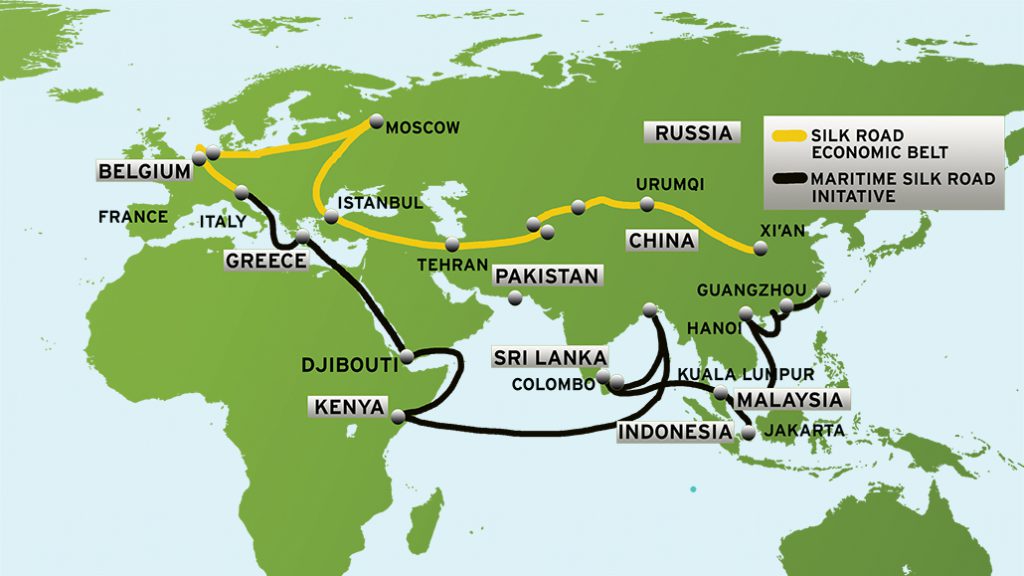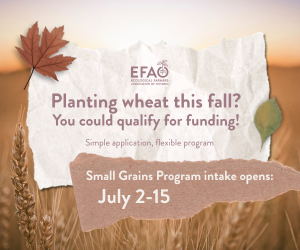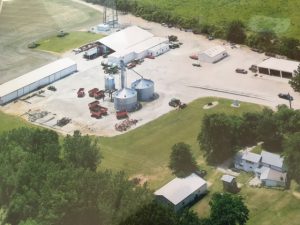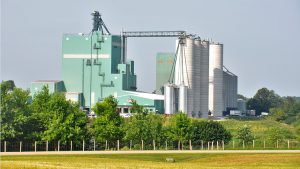Belt and Road Initiative
CHINA`S DEVELOPMENT STRATEGY


Founder and Executive Chairman, Mahon China Investment Management
CHINA`S BELT AND Road Initiative is a development strategy with a focus on connecting Eurasian countries through a land-based road as well as a maritime route. The ‘belt’ is the Silk Road Economic Belt and includes the new development of railroads and highways. The ‘road’ refers to the Maritime Silk Road and the plan to build new ports along maritime routes.
China’s leader, Xi Jinping, proposed the initiative in September 2013. Since its proposal, there has been much concern amongst those who export to China that the initiative could close already established and future markets. In a recent interview, David Mahon of Mahon China Investment Management explained how it could impact Ontario’s exports of agricultural commodities.
M.E.: WHAT IS CHINA’S BELT AND ROAD INITIATIVE AND WHAT IS ITS PURPOSE?
D.M.: Belt and Road is a central government strategy that has a variety of aims, amongst which are a need to frame China’s relationship with its nearest neighbours. As much as China has huge internal capacities, particularly when it comes to things that support infrastructure — property development, traditional industries like steel, aluminum, and glass — it’s looking to try and utilize that capacity to help build the economies of its neighbours, the central Asian republics, Kazakhstan, Uzbekistan, and Kyrgyzstan. China wants those countries to become wealthier so their middleclass citizens will buy more of their products.
Belt and Road is really a web that takes into account anything where China can secure economic relationships with countries, where it can actually relate by selling its products or where necessary, create a flow of the goods and resources it needs itself.
DOES BELT AND ROAD HAVE AN AGRICULTURAL OBJECTIVE?
Belt and Road is also meant to service China’s need to feed itself, something which it is increasingly less able to do, as the population becomes more sophisticated and demanding, and as the urban population grows. Currently, 56 per cent live in cities. But China doesn’t have the land, water, or level of fertility to actually grow grain to produce protein to feed itself. In central Asia it has purchased — where some countries have only been allowed to lease — millions of hectares of land in order to grow protein of various kinds such as some beef herds and dairy herds. They’re also looking at grain production for higher-end grain. So Belt and Road, to that degree, does have an agricultural objective.
From a Canadian perspective, Belt and Road’s relevance is very much around agriculture and food, and very much around protein. But even feed grains have a role here. At the right time of year, one sees that China’s feedlot farms — the coastal farms on the east coast of China — will be purchasing alfalfa from Washington State in the U.S. because it’s cheaper than purchasing and shipping alfalfa from the northeast and central provinces of China. So really there is a very broad spectrum of what China is buying and shipping back to itself.
WHAT CAN ONTARIO GROWERS DO TO ENSURE THAT THEY DON’T LOSE MARKET IN CHINA?
If I was looking at it from a Canadian perspective, I would look at it as where can I get investment from China into processing in agriculture in Canada to form the kind of partnership that allows me to get more value out of selling my goods to China. You could seek to develop within the context of a Belt and Road Initiative because it may bring with it a chance for the Canadian government to have discussions with Chinese customs and quarantine, and to simplify and accelerate the passage of Canadian goods into China.
It’s quite an interesting context. If you think of anything you may need in trade and diplomacy, and could put it into the context of Belt and Road, it would get special focus from the Chinese government.
Canada will miss out to the extent that it doesn’t engage with China, in general, not whether it gets Belt and Road right in the next 24 months. In the end, it’s like anything, if you’re producing products of quality that China needs, they will buy them. I think the thing to be careful of is that if you are — and I’m thinking of Ontario, being a major exporter to China — the obligation is on Ontario to look at how they can be more than just suppliers to a market, but to engage more in China. Have a presence in China wherever possible. Try and look more at getting involved in the distribution of products here to ensure that the best image and the best result of selling to China is being achieved.
There is a tendency by Western firms, particularly those that are producing agricultural products, to put goods in boxes and send them off from ports and that’s it. Canada is certainly not alone in that. Australia and New Zealand both suffer from that minimal relationship with trade with China. It’s very important to know your customers here and to an extent, the Chinese consumer themselves. Know where the trends are going because — in food particularly — there have been incredible changes in China in the past 10 years. The melamine crisis in 2008 and 2009 in the dairy sector… the shock was so great that Chinese consumers really started looking hard at everything they consumed. Integrity of food and integrity of ingredients — all of this is becoming more and more of an issue.
It’s difficult in many ways because grain is more of an ingredient, so you’re not really able to establish an identity. You wouldn’t be trading grain online in ordinary ways. Grain would be going into the ingredients for finished products in China. It’s a commodity, so it’s a different dynamic. But if, for instance, the sale of grain from Ontario into China has good margins, it’s important to know what they’re being used for, what end products people are consuming, so you understand the demand dynamics here — because that could change.
It’s not that China would possibly begin to use its own resources because if they’re already buying from Ontario it will be that the quality and price is better. Keep in mind, if you want to run an intensive dairy farm here in China, it’s far more expensive than to run one in Canada. Everything is more expensive — local feed, use of water, treatment of effluent — the land itself is 10 times sometimes what that same plot of land would be in Canada. If you’ve already got good trade with China, it’s just a matter of knowing who the end users of those processed products are.
David Mahon is the Founder and Executive Chairman of Mahon China Investment Management Ltd. He has managed five private equity portfolios in China and held direct responsibility for the management of over 25 Chinese companies. Mahon has extensive experience advising multinationals on their strategies in China and has served on the boards of international and Chinese financial and industrial firms. Mahon writes and publishes China Watch, a quarterly review of China’s political, economic and social developments. He is also a regular commentator in the Chinese and international news media. Mahon has been a resident of China for more than 30 years. •



















